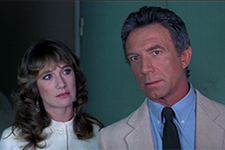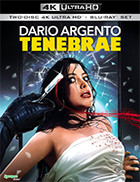Tenebrae (4K UHD)
|  You see it in the corner of the room, and if you’ve seen another Dario Argento film, you know what will eventually happen, if only subconsciously. The “it” is a large, seven-foot modern metallic sculpture composed entirely of what looks like a jumble of shiny silver spikes. It sits in the corner of an apartment where the bloody climax of the film takes place, and you know that it is not just passive decoration. While I won’t give away exactly how it is incorporated into the action, I will say that it is just as spectacular and gruesome as you might imagine, just a hair’s breadth away from being utterly silly. But, then again, that is the heart and soul of Argento’s films: simultaneously rigorous and ridiculous, a curious blend of Alfred Hitchcock’s suspenseful sadism and Michelangelo Antonioni’s arty ennui with a dash of mad hatter surrealism just for good measure. Tenebrae marked Argento’s return to the giallo—hyperstylized mysteries obsessed with extended murder sequences and bizarre psychoses—after making the supernatural horror films Suspiria (1977) and Inferno (1980). And, while Argento had begun his career with a series of particularly stylized gialli—The Bird With the Crystal Plumage (197o), Cat O’ Nine Tails (1971), and Four Flies on Grey Velvet (1971)—Tenebrae marked a particularly self-conscious turn for him, as it is at once an over-the-top roll in all the most gruesome and outlandish of Argento’s preoccupations (beautiful women being graphically slaughtered, relentlessly roving camerawork, a bombastic musical score) and an aggressive defense of them. The film’s protagonist, Peter Neal (Anthony Franciosa), is an American author who writes the literary equivalent of Argento’s films. The plot involves a series of murders in Rome that seem to correspond with Neal’s latest novel (well, definitely correspond to the extent that the first victim has her mouth stuffed with pages torn from the paperback) just as the author is on a press tour there. When the police arrive at his doorstep, Neal sardonically asks them if they interview the president of Smith & Wesson every time someone is killed with a gun. A cheap shot, to be sure, but it is only the most overt of Argento’s sly melding of reality and fantasy, which is the film’s primary theme. In Tenebrae, art literally kills in more ways than one, but the film’s exaggerated style and tone work against the obvious to remind us that fiction is still fiction. One of the most frequent criticisms of Argento’s films is their narrative incomprehensibility, which makes Tenebrae something of an outlier in that he constructs a solid narrative that (mostly) adheres to logic and reason, right down to that bloody climax. Of course, there are a few random detours here and there, such as Argento solving the problem of how to get a young woman into the killer’s house by having her chased there by a gnashing Doberman. It’s exactly the kind of “Huh?” scenario that confounds first-timers, although longtime admirers of his work will have no problem digesting it. The killer’s identity is keep cleverly guarded until the end, with Argento throwing out a number of potential suspects, including Neal’s obsessive ex-wife (Veronica Lario), his self-absorbed publicist (John Saxon), his doting secretary (Daria Nicolodi), and even the inspector in charge of the case (Carola Stagnaro), who happens to mention early on that he’s a big fan of Neal’s work. And let’s not also count out the snooty book critic (John Steiner) who seems a little too intent on reading into Neal’s stories about depraved killers. As a mystery, Tenebrae works extremely well, drawing you into the pulpy scenario and keeping you transfixed even as suspect after suspect gets knocked off. The film’s style is quite different from Argento’s previous efforts, relying on a cold, sterile look that emphasizes white marble, modern architecture, and empty space instead of the baroque architectural trappings and gaudy colored lights that defined his previous films. Argento also indulges in some particularly extravagant camerawork that seeks to out-De Palma Brian De Palma, including a stunning crane shot that crawls across the front of an apartment building, peering through windows while sustaining an unbroken sense of dread. The murder sequences are just as compelling and spectacular as you would expect, and Argento seems to have reversed the strategy of Hitchcock’s Psycho (1960) in making each one successively more grandiose. The first killing, while certainly gruesome, seems positively restrained by Argento’s standards, while the final 15 minutes turns into a literal slaughterhouse, with hacked off limbs, spurting arteries, and unexpected axes into the back. It also features one of the hands-down best killer reveals in modern cinema.
Copyright © 2023 James Kendrick Thoughts? E-mail James Kendrick All images copyright © Synapse Films | |||||||||||||||||||||||||||||
Overall Rating: 

 (3)
(3)


